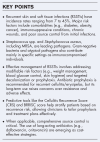Recurrence of skin and soft tissue infections: identifying risk factors and treatment strategies
- PMID: 39882704
- PMCID: PMC11872275
- DOI: 10.1097/QCO.0000000000001096
Recurrence of skin and soft tissue infections: identifying risk factors and treatment strategies
Abstract
Purpose of review: Recurrent skin and soft tissue infections (RSSTIs) are challenging for the clinicians due to morbidity and healthcare-related costs. Here, we review updates on risk factors and management.
Recent findings: RSSTIs rates range between 7 and 45%. Local and systemic conditions can favour RSSTIs, with comorbidities such as obesity, diabetes, cancer and immunosuppressive disease becoming increasingly relevant. Streptococcus spp . and Staphylococcus aures (including methicillin resistant, MRSA) are the leading causative pathogens of RSSTIs, but also Gram-negative bacteria and polymicrobial infection should be considered. To prevent recurrences, treatment of underlying predisposing factor, complete source control and appropriate antibiotic therapy are crucial. Antibiotic prophylaxis for recurrent erysipelas and decolonization for MRSA carriers demonstrated some advantages, but also long-term loss of efficacy and possible adverse effects. Clinical score and patients risk stratification could be useful tools to target prophylaxis and decolonization strategies. To reduce hospitalization rates and costs, outpatient oral and parenteral antibiotic therapy (OPAT) and long-acting antibiotics are being implemented.
Summary: Management of RSSTIs requires both preventive interventions on modifiable risk factors and pharmacological strategies, with a patient tailored approach.
Copyright © 2025 The Author(s). Published by Wolters Kluwer Health, Inc.
Conflict of interest statement
References
-
- Esposito S, Noviello S, Leone S. Epidemiology and microbiology of skin and soft tissue infections. Curr Opin Infect Dis 2016; 29:109–115. - PubMed
-
- Lautz TB, Raval MV, Barsness KA. Increasing national burden of hospitalizations for skin and soft tissue infections in children. J Pediatr Surg 2011; 46:1935–1941. - PubMed
-
- Vella V, Derreumaux D, Aris E, et al. . The incidence of skin and soft tissue infections in the United States and associated healthcare utilization between 2010 and. Open Forum Infect Dis 2024; 11:ofae267. - PMC - PubMed
-
A retrospective observational cohort study which provides updated epidemiological information on SSTIs in a large (5.4 million patients) North-American population.
Publication types
MeSH terms
Substances
LinkOut - more resources
Full Text Sources
Medical
Research Materials
Miscellaneous


